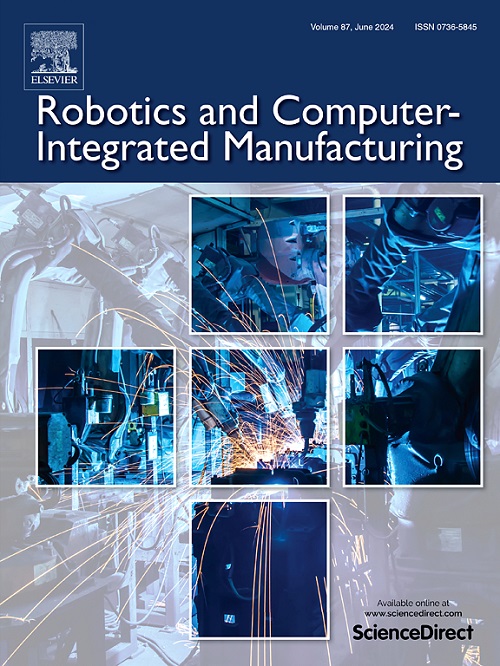基于力传感的弱刚度薄壁零件机器人铣削柔性误差补偿控制
IF 11.4
1区 计算机科学
Q1 COMPUTER SCIENCE, INTERDISCIPLINARY APPLICATIONS
引用次数: 0
摘要
工业机器人在铣削作业领域具有相当大的潜力。然而,由于其结构特点,在铣削过程中经常出现较大的加工误差。对于机器人铣削,现有的研究很少提供直接的加工误差补偿控制策略,这限制了工业机器人在高精度加工任务中的进一步应用。为了提高机器人铣削精度,提出了一种基于力传感的误差补偿控制方法。首先,为了预测切削力与加工参数之间的关系,引入材料去除参数Sl,建立了改进的切削力模型,将切削力信号与机器人的位置数据相结合,可以预测加工误差。在此基础上,结合机器人和工件的刚度特性,提出了一种误差补偿控制方法。利用机器人的空间位姿和工件模型生成初始铣削轨迹。基于力传感和所需的加工精度,自适应调整切削参数。结合机器人运动数据、加工数据和切削力信号,提出了一种数据驱动的自适应参数调整策略。通过调整不同超差区域的进给速度,生成新的补偿铣削轨迹,从而修正加工误差。为了验证该方法的有效性,对薄壁轻合金工件和特征部件进行了机器人铣削实验。实验结果表明,该方法显著降低了机器人铣削加工误差,提高了加工质量和效率。这些结果表明,该方法在复杂薄壁结构的高精度机器人铣削加工中具有很强的潜力。本文章由计算机程序翻译,如有差异,请以英文原文为准。
Force-sensing-based compliant error compensation control for robotic milling of weak-stiffness thin-walled components
Industrial robots hold considerable potential in the field of milling operations. However, due to their structural characteristics, significant machining errors often occur during the milling process. For the robotic milling, existing research rarely provides direct control strategies for machining error compensation, which limits the further application of industrial robots in high-precision machining tasks. To enhance the robotic milling accuracy, this paper proposes an error compensation control method based on force sensing. First, to predict the relationship between cutting forces and machining parameters, an improved cutting force model is developed by introducing the material removal parameter Sl. Combining the cutting force signals with the robot's position data, the machining error can be predicted. Furthermore, by considering the stiffness characteristics of both the robot and the workpiece, an error compensation control method is proposed. The initial milling trajectory is generated using the robot’s spatial pose and the workpiece model. Based on force sensing and the desired machining accuracy, the cutting parameters are adaptively adjusted. A data-driven adaptive parameter adjustment strategy is further proposed by integrating robot motion data, machining data, and cutting force signals. By adjusting the feed rate in different out-of-tolerance regions, a new compensated milling trajectory is generated to correct machining errors. To validate the effectiveness of the proposed method, robotic milling experiments were conducted on thin-walled light alloy workpieces and feature components. The experimental results demonstrate that the proposed approach significantly reduces machining errors in robotic milling, thereby improving both machining quality and efficiency. These results indicate that the proposed method has strong potential for high-precision robotic milling of complex thin-walled structures.
求助全文
通过发布文献求助,成功后即可免费获取论文全文。
去求助
来源期刊
CiteScore
24.10
自引率
13.50%
发文量
160
审稿时长
50 days
期刊介绍:
The journal, Robotics and Computer-Integrated Manufacturing, focuses on sharing research applications that contribute to the development of new or enhanced robotics, manufacturing technologies, and innovative manufacturing strategies that are relevant to industry. Papers that combine theory and experimental validation are preferred, while review papers on current robotics and manufacturing issues are also considered. However, papers on traditional machining processes, modeling and simulation, supply chain management, and resource optimization are generally not within the scope of the journal, as there are more appropriate journals for these topics. Similarly, papers that are overly theoretical or mathematical will be directed to other suitable journals. The journal welcomes original papers in areas such as industrial robotics, human-robot collaboration in manufacturing, cloud-based manufacturing, cyber-physical production systems, big data analytics in manufacturing, smart mechatronics, machine learning, adaptive and sustainable manufacturing, and other fields involving unique manufacturing technologies.

 求助内容:
求助内容: 应助结果提醒方式:
应助结果提醒方式:


